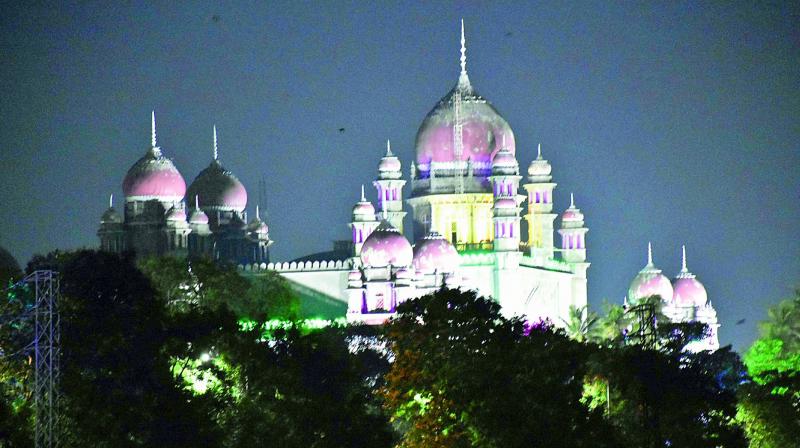Hyderabad high court building turns 100 years old
One of first HCs to be set up in any princely state has largest and highest Indo-Saracenic arch.

Hyderabad: The Hyderabad High Court building completes 100 years of its existence on Saturday. It was one of the first High Courts to be set up in any princely state of India.
In Nizam era, this court was called Adalatul Aaliya Osmania (Higher court of Osman Ali Khan) and later renamed ‘High Court of Andhra Pradesh’, as it was set up on November 5, 1956 under the States Reorganisation Act 1956.
A regular and efficient judicial system was introduced in Hyderabad State by Sir Salar Jung, the Prime Minister of Hyderabad State (1853-83).
Mohammed Safiullah of the Deccan Heritage Trust says the unique Osmanian architectural style of the Hyderabad High Court has the largest and highest Indo-Saracenic arch anywhere in the country, much larger than the Bulund Darwaza at Fatehpur Sikri in Agra.
The building is commonly believed to have cost 18,22,750 Sikkah Osmania, but Mr Safiullah believes it cost about 28 lakh Sikkah Osmania.
The court was constructed on the ruins of the Qutub Shahi palaces, Hina Mahal and Nadi Mahal, and the construction commenced on April 15, 1915 and was completed on March 31, 1919. The highlight of the building is the use of distinctive pink coloured granite and red sandstone in the panels of the building.
The High Court functioned from five places in the city before it was accomodated in the current building. There was a High Court in Pathergatti before the present one was erected. Due to the flooding of the River Musi in 1909, this court was shifted to the Devdi (residential building) of Nawab Sir Asman Jah, at Lal Bagh. In 1912, when a cholera epidemic hit Hyderabad city, the High Court was shifted yet again to the Address Hall in Public Gardens. After about four months, the court was relocated to Lakkad Kote, the house of Nawab Salar Jung Bahadur, at Chatta Bazaar. This was found to be unsuitable, and the house of Nawab Sartaj Jung at Saifabad was obtained on rent, and the High Court was shifted to his building in 1914. It was at this time that construction of the present High Court building began.
It was inaugurated by Mir Osman Ali Khan, the VII Nizam of Hyderabad, on April 20, 1920. On the occasion, a model of the building engrafted on a silver plaque weighing 300 kg was presented to Mir Osman Ali Khan, which is now on display at Nizam’s Museum Purani Haveli.
On 31 August 2009, a major accidental fire broke out through the building in which eight judge chambers were gutted and damaged a library and a conference hall. In fire rare England law reports, privy council journals and life-size portrait of Nizam and portraits of judges were gutted.
It is said that the plan of the building was drawn up by Shankar Lal of Jaipur, an eminent engineer and architect of those times and the design was sanctioned with minor modification in the plan from Vincent J. Esch, a celebrated British architect and engineer and executed by a local engineer, Mehar Ali Fazal. The implementing agency was the City Improvement Board.
At the time of its inauguration, the High Court had only six judges and accommodated offices, record rooms and an Advocate's Hall in addition to majestic Court Halls
Some advocates have demanded that a portrait of the Seventh Nizam, Mir Osman Ali Khan, be hung in the Bar Association Hall as a tribute to him.

